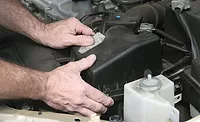Frequently asked questions about vehicle maintenance
Fleet maintenance experts weigh in on important steps

Because vehicle maintenance is essentially the mechanical equivalent of keeping up with your regular physicals and other necessary doctor’s appointments, it’s time for a bit of a checkup. We talked to some fleet maintenance technology experts and put together a bit of a FAQ list to help you ensure that everything’s in tip-top shape.
What are the biggest challenges fleets face in implementing a sound maintenance program?
According to Jeremiah Mancini, executive vice president of global sales for maintenance software supplier Forward Thinking Solutions, the biggest challenge is identifying a maintenance solution that can manage utilization, engine hours, and mileage across all fleet assets. Additionally, the system would need to allow for proactive alerts well in advance of required maintenance that’s coming due on those vehicles, as well as offer scheduled reports to quickly identify both past due and upcoming maintenance needs.
Getting maintenance schedules aligned across the fleet is another challenge that needs to be addressed, says Bob Hausler, vice president of Transport North America for maintenance solution provider AMCS Group. Make sure, for instance, that your maintenance system offers the right metrics to track yourself, as a sort of scorecard.
“Not only did I get the work order, capture the labor, capture the time and the parts, but did I get it done on time?” Hausler explains. “If I was late, how late was it? If I did it early, how early was it? [With that information], you can sort of refine your processes a little bit.”
What are the areas that fleets most habitually neglect in their maintenance plans?
The general answer is preventive maintenance.
“The number one area where we’re focused is prevention,” Hausler says. “It costs four times as much to deal with a breakdown as the maintenance that would’ve prevented it.”
He notes that most fleets don’t necessarily fully neglect preventive maintenance, but some of it “slips through the cracks.”
From Mancini’s perspective, one of those areas that can commonly slip through the cracks is the enforcement of inspection reports. “A system that can ensure that these are done and notify when not complete or when exceptions are identified can be a key element in supporting fleet managers and ensuring a reduced M and R [maintenance and repair] costs.”
One other specific area that’s often overlooked is the torque on the lugs of a wheel.
“Whenever you have a wheel-off event, it’s almost always tragic in its outcome,” Hausler says.
AMCS Group recently added a feature to its system that licenses technology based on codes established by American Trucking Association’s Technology & Maintenance Council that will remind the operator to verify the torque after a specific mileage or time interval.
What’s an easy action drivers can apply on a daily basis to help maintain their vehicles?
A quick, daily digital vehicle inspection report (DVIR), Mancini says, can go a long way in catching issues before they become complete failures or breakdown events.
What’s a more long-term best practice fleets can implement?
Define and document standard processes for repairs, based largely on historical evidence within your operation.
“If I’m doing this preventive maintenance job, if I’m doing this brake reline — and all the way down to the other end of the spectrum [like] an engine overhaul — have these processes set up and documented so that A: when your technicians are doing the work, they can follow that cookbook and so that B: you can start to build a benchmark database,” Hausler says.
That will give you an idea of how long a particular job should take.
“So if you define this repair job after you’ve done it four, five times, we can, ‘OK, that is an hour,’” Hausler notes. “Hmm, it takes Joe an hour and a half, so Joe might need a little more training. Or, on the other side, it’s only taking Fred 45 minutes to do something that we know takes an hour, which probably means that there are some steps being skipped here.”
Looking for a reprint of this article?
From high-res PDFs to custom plaques, order your copy today!








